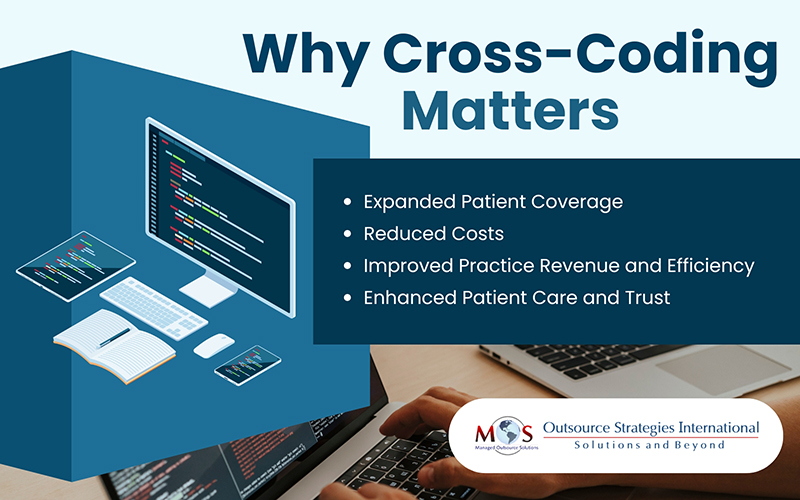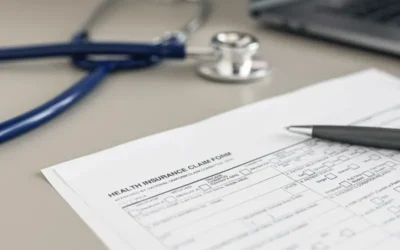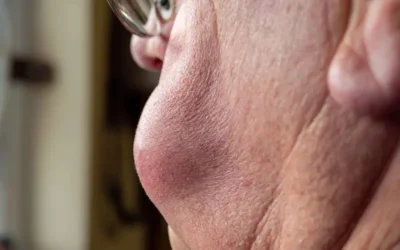Dental insurance, while useful for routine care, often has limitations that create challenges for both patients and providers. Many procedures with dental components are related to broader medical conditions, yet dental plans may not provide coverage for them. Many patients often ask, “Does medical insurance cover dental procedures?” The answer depends on whether the treatment is considered medically necessary and linked to a documented medical condition.
Dental-medical cross-coding enables providers to bill medical insurance for qualifying procedures, helping patients access the care they need. It involves billing a patient’s medical insurance for dental procedures that are considered medically necessary. When used effectively, cross-coding with medical billing can expand patient coverage, reduce out-of-pocket costs, and streamline dental billing and reimbursement.
Cross-coding to medical involves translating dental procedure codes (CDT codes) into medical codes (CPT and ICD-10 codes). Because this demands a thorough understanding of both dental and medical coding systems, partnering with a medical billing and coding company experienced in dental revenue cycle management (RCM) can help maximize reimbursement and expand patient access to medically necessary treatments.
In this post, we discuss what cross-coding involves and offer tips for accurate cross-coding in dental and medical claims.
What is Dental Cross-Coding with Medical Billing?
Dental cross-coding with medical billing is the process of billing a patient’s medical insurance for dental procedures that are considered medically necessary. It involves using CPT and ICD-10 codes to bill medical insurance for dental procedures that are medically necessary due to an underlying condition, injury, or pathology. This helps patients use their medical insurance benefits for treatments that would normally come under dental coverage. Cross-coding is especially useful in situations where dental insurance coverage is limited or exhausted.
There are a wide range of dental procedures that can potentially be cross-coded to medical insurance. These include sleep apnea appliances, TMJ therapy, oral surgeries (e.g., wisdom tooth extractions, biopsies), bone grafting, treatment for oral infections or injuries, and certain diagnostic tests and X-rays related to medically necessary procedures.
By correctly cross-coding, dental practices can maximize reimbursements and reduce claim denials, leading to improved RCM.
How to Cross-code Dental Procedures for Medical Insurance
While cross-coding offers significant benefits, it presents challenges such as incorrect coding, incomplete documentation, and confusion about billing order. The following guide provides key steps and best practices for dental offices to successfully implement cross-coding in medical billing:
- Ensure Accurate and Thorough Documentation
Gather all relevant documentation, including patient complaints, clinical findings, diagnostic tests (e.g., CBCT scans for TMJ disorders, sleep studies for sleep apnea), documentation of symptoms that justify medical necessity and treatment, and referrals from other healthcare providers. Medical necessity documentation not only supports the claim, but also improves patient care and reduces the chances of audits.
- Verify Insurance Coverage and Prior Authorization
Before cross coding, perform patient insurance eligibility verification to understand insurance coverage and prior authorization requirements. This is essential to confirm if the procedure qualifies for medical insurance under the patient’s plan.
Understanding prior authorization requirements is crucial as many medical insurers require pre-authorization for procedures like oral surgery, sleep apnea treatment, and TMJ therapy. If pre-authorization is needed, submit the request early and include all required supporting documentation, such as the diagnosis codes, procedure details, and clinical notes.
Verifying insurance coverage in advance also allows practices to inform patients about their out-of-pocket costs.
- Assign the Correct Medical Codes
CDT codes should be translated into the correct CPT codes and ICD-10 codes. Refer to the latest CDT, CPT, and ICD-10 codes and guidelines, as these are updated regularly. Ensure that the selected medical codes accurately reflect the diagnosed medical condition and the treatment provided. For e.g., a dental code D7140 for an erupted tooth extraction could be cross-coded to CPT code 41899 (unlisted procedure, dentoalveolar structures) or 41820 (excision of intraoral soft tissue lesion). Utilize correct CPT modifiers to convey additional information about a procedure, such as a separate evaluation (-25) or a distinct procedural service (-59).
- Establish Medical Necessity
To be covered by medical insurance, the procedure must address a diagnosed medical condition, injury, or pathology. Clearly link the dental procedure to the medical diagnosis. Provide a strong justification why the dental procedure is medical necessary and not purely elective or cosmetic. For e.g., if the patient has sleep apnea, explain how not treating the condition can lead to cardiovascular issues, and that an oral appliance is required to manage it.
Ensure the diagnosis supports the treatment using appropriate ICD-10 codes linked to a medical condition. For example, consider a patient who presents with OSA (obstructive sleep apnea – ICD-10 code G47.33) and requires an oral appliance as part of their treatment plan. While the appliance is produced by a dentist, the procedure can be billed to medical insurance only if the diagnosis code clearly supports the medical necessity.
The correct linkage:
- Diagnosis – ICD-10 code G47.33 – Obstructive sleep apnea (adult) (pediatric)
- Procedure – CPT code E0486 – Oral device/appliance used to reduce upper airway collapsibility (used with OSA)
In this case, the diagnosis of sleep apnea medically justifies the need for the oral appliance, increasing the likelihood of claim approval by the medical payer.
- Implement Efficient Billing Practices
Claims should be submitted promptly (within 24-48 hours) to ensure efficient processing and avoid delays in reimbursement. Electronic claim submission and coding streamlines the process and reduces errors
Tracking the status of submitted claims and following up promptly on pending or denied claims is essential to avoid delays. It’s also necessary to have proper processes in place for appealing denied claims. Implementing regular coding and billing audits can help to identify and address any errors or inconsistencies for prompt correction.
Why Cross-Coding is Important
Accurately cross-coding dental procedures for medical insurance benefits both patients and providers:
- Expanded Patient Coverage – allows patients to utilize their medical insurance for procedures that may not be covered by dental plans
- Reduced Costs – increases patients’ coverage options and potentially reduces their out-of-pocket expenses.
- Improved Practice Revenue and Efficiency: maximizes dental practice reimbursements and reduces claim denials, leading to RCM.
- Enhanced Patient Care and Trust: allows dentists to provide medically necessary treatments for a wider range of conditions, building greater patient trust in their practice.

Optimize Cross-Coding with Medical Billing – Reach out to Experts
By adhering to the above tips and best practices, dental practices can navigate the intricacies of cross-coding effectively. However, this can be challenging when your primary focus is patient care. Outsourcing dental billing to experts can ensure access to certified coders who are well-trained and up-to-date on dental medical coding, including CDT and ICD coding changes and guidelines. Working with professional dental billing services can significantly improve the accuracy and efficiency of cross-coding, minimize claim denials, and maximize reimbursement.
Streamline your revenue cycle with our dental billing services.




